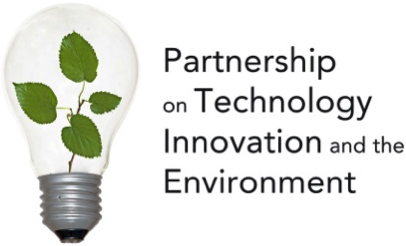You are here: American University School of Public Affairs Center for Environmental Policy Projects Partnership on Technology Innovation and the Environment
Contact Us
Partnership on Technology Innovation and the Environment Advances AI and Machine Learning for Environmental Protection

Since 2012, the Center for Environmental Policy has nurtured a partnership with government, business, investment, academic, and environmental organizations to accelerate the development, adoption, deployment, scale-up, and export of technologies for energy, water, and materials that protect health and the environment.
The Partnership on Technology Innovation and the Environment (PTIE) was founded on the premise that multi-sector collaboration can uniquely catalyze and enable substantive innovation and technology deployment that no sector could achieve alone. Original members included:
-
Institute for Environmental and Energy Management, the George Washington University
-
The Initiative for Global Environmental Leadership, The Wharton School, University of Pennsylvania
-
World Business Council for Sustainable Development
The Center for Environmental Policy supports the Partnership through management and analysis. The Partnership grew out of the Technology Market Summit held at American University in May 2012. For more information on the Partnership, please see the Partnership Agreement.
2018 - Environmental Protection, Artificial Intelligence and Machine Learning
The September 21, 2018, Workshop on Environmental Protection, Artificial Intelligence and Machine Learning, brought together experts from many fields to explore, evaluate, and propose ways of using artificial intelligence (such as machine learning and natural language programming) in environmental protection. The workshop focused on two specific areas of environmental decision making as case studies: water quality (especially nutrient) management and chemical risk assessment.
Summary Report
2017 - Lead Data and Monitoring
The May 3, 2017, PTIE convening Dialogue on Lead Data and Monitoring, focused on the capacities and challenges for identifying sources of lead risks in drinking water, with an emphasis on lead service lines. Topics addressed included the sources of best practices in targeting such sources of lead exposure and options for expanding them; priorities for policy research and technology development; and use and sharing of data of this kind to support broader public health efforts and monitoring methods to reduce lead exposure. This convening was held in partnership with the Lead Service Line Replacement Collaborative.
Summary Report
2015 - Nutrient Monitoring to Support Water Quality Improvement
The purpose of the June 24, 2015, workshop on Nutrient Monitoring to Support Water Quality Improvement was to solicit ideas and recommendations on designing a project to simulate water quality trading on a sub-watershed of the Chesapeake Bay. This proposal was linked with the Nutrient Challenge underway at EPA, which aims to reduce the costs of nutrient sensing technology by 80% from current levels. This workshop emerged from the interest among members of the Partnership on Technology Innovation and the Environment in promoting use of in-stream sensors, linked with other data sources, to facilitate water quality trading by reducing uncertainties associated with use and measurement of Best Management Practices (BMPs) for point/non-point source trading. The model would enable stakeholders to run simulations to show how real-time and remote sensing can validate agricultural and municipal BMP effectiveness.
Summary Report
2014 - Water Technology Adoption
The Partnership identified gaps in current efforts through a consultative process that began in January 2014 and included its June 27 Expert Workshop on Water Technologies that built on the EPA Water Technology Innovation Blueprint with a focus on the topics: (1) Challenging nutrients: Technology innovation for better water quality; and (2) Developing viable wastewater treatment business models by leveraging innovative financing and technology.
The premise of this initiative is that accelerating deployment of existing technologies holds great potential for addressing complex challenges for water resources and increasing climate resiliency.
2012 - Technology Market Summit
Jointly sponsored by EPA and American University, the May 14, 2012, Summit brought together government, industry, academia and investment decision makers to accelerate the development and adoption of technologies to achieve economic growth through environmental protection. Topics included: 1) Fenceline Air Quality Monitoring; 2) Automotive Supply Chain; and 3) Biodigesters and Biogas.
Learn More
